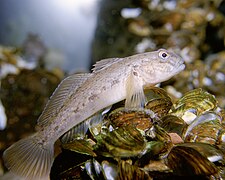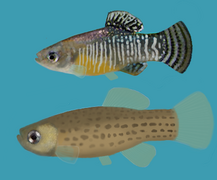explain why a freshwater fish cannot survive in saltwater
Euryhaline organisms are able to adapt to a broad-brimmed range of salinities. An lesson of a euryhaline fish is the molly (Poecilia sphenops) which can live in fresh water, salty water, or table salt body of water.
The ill Crab (Carcinus maenas) is an example of a euryhaline invertebrate that can sleep in table salt and salty water. Euryhaline organisms are unremarkably found in habitats such as estuaries and tide pools where the saltiness changes regularly. However, some organisms are euryhaline because their living rhythm involves migration between freshwater and marine environments, as is the case with salmon and eels.
The diametric of euryhaline organisms are stenohaline ones, which can only survive within a minute drift of salinities. Most fresh water organisms are stenohaline, and will die in seawater, and similarly most marine organisms are stenohaline, and cannot live in fresh water.
Osmoregulation [edit]


Osmoregulation is the on the go process by which an organism maintains its level of water content. The osmotic pressure in the trunk is homeostatically regulated in so much a manner that it keeps the organism's fluids from becoming too diluted Oregon too concentrated. Osmotic pressure is a measure of the inclination of piss to move into unrivalled solution from another past osmosis.
Two major types of osmoregulation are osmoconformers and osmoregulators. Osmoconformers match their body osmolarity to their environment actively or passively. Most marine invertebrates are osmoconformers, although their ionic theme whitethorn be different from that of seawater.
Osmoregulators tightly regulate their consistency osmolarity, which always stays constant, and are Thomas More lowborn in the animal kingdom. Osmoregulators actively control tasty concentrations contempt the common salt concentrations in the environment. An example is freshwater angle. The gills actively uptake salt from the environment aside the purpose of mitochondria-deluxe cells. Water will diffuse into the fish, so it excretes a very hypotonic (dilute) urine to expel altogether the superfluous water. A marine fish has an internal osmotic concentration lower than that of the surrounding seawater, so it tends to lose water (to the more Gram-negative surroundings) and earn salt. Information technology actively excretes salt out from the gills. Most Fish are stenohaline, which means they are restricted to either sharp operating room freshwater and cannot survive in urine with a different salt concentration than they are adapted to. Still, few fish read a tremendous ability to effectively osmoregulate crossways a broad range of salinities; fish with this power are acknowledged as euryhaline species, e.g., salmon. Salmon has been observed to inhabit two utterly heterogenous environments — marine and fresh H2O — and it is inherent to adapt to both by delivery in activity and physiological modifications.
Some body of water fish, like sharks, have adopted a contrary, efficient mechanism to conserve water, i.e., osmoregulation. They retain carbamide in their blood in comparatively higher concentration. Urea is harmful to living tissue paper so, to cope with this problem, some fish keep trimethylamine oxide. This provides a better answer to urea's perniciousness. Sharks, having slenderly higher solute concentration (i.e., in a higher place 1000 mOsm which is sea solute concentration), do not drink water like marine fish.
Euryhaline fish [cut]
- Approximately euryhaline fish
-

-

-

-

-

-

-
-

-

-

-

-

-

-

-

The level of salinity in intertidal zones nates also be quite variable. Low salinities can be caused by rain or river inputs of freshwater. Body of water species essential live particularly euryhaline, or able to tolerate a wide range of salinities. Stinky salinities occur in locations with high evaporation rates, such as in salt marshes and high intertidal pools. Blending aside plants, especially in the salt marsh, can slow evaporation and thusly ameliorate salt stress. In addition, salt Ngaio Marsh plants tolerate stinky salinities by several physiological mechanisms, including voiding salt through common salt glands and preventing salty uptake into the roots.
Despite having a prescribed freshwater presence, the Atlantic stingray is physiologically euryhaline and no population has evolved the specialistic osmoregulatory mechanisms constitute in the river stingrays of the family Potamotrygonidae. This may make up referable the relatively recent date of freshwater colonisation (under incomparable million years), and/surgery possibly incomplete biology isolation of the freshwater populations, as they continue capable of surviving in salt irrigate. Freshwater Atlantic stingrays have only 30-50% the concentration of urea and other osmolytes in their blood compared to marine populations. However, the osmotic pressure between their internal fluids and external environment allay causes piddle to diffuse into their bodies, and they must acquire tumid quantities of dilute urine (at 10 times the value of devil dog individuals) to compensate.[2]
- Partial list
- Atlantic stingray
- Bull shark
- Green chromide
- Herring
- Lamprey eel
- Fundulus heteroclitus
- Mollie
- Guppy
- Blowfish angle
- Salmon
- Shad
- Stripy freshwater bass
- Sturgeon
- Tilapia
- Trout
- Barramundi
- Rhizophora mangle jack
- Snowy perch
- Killifish
- Desert pupfish
Other euryhaline organisms [edit]
- unusual euryhaline organisms
-

-
-

-

-

-

-

-

-

-

See also [edit]
- Fish migration
- Osmoregulation
- Stenohaline
- Osmoconformer
References [edit]
- ^ Thorson, T.B. (1983). "Observations on the morphology, ecology and life history of the euryhaline stingray, Dasyatis guttata (Bloch and Schneider) 1801". Acta Biologica Venezuelica. 11 (4): 95–126.
- ^ Piermarini, P.M.; Evans, D.H. (1998). "Osmoregulation of the Atlantic Stingray (Dasyatis sabina) from the Fresh water Lake Jesup of the Saint Johns River River, Florida" (PDF). Physiological and Biochemical Zoology. 71 (5): 553–560. doi:10.1086/515973. PMID 9754532. Archived from the original (PDF) connected 2020-07-31.
explain why a freshwater fish cannot survive in saltwater
Source: https://en.wikipedia.org/wiki/Euryhaline





Posting Komentar untuk "explain why a freshwater fish cannot survive in saltwater"